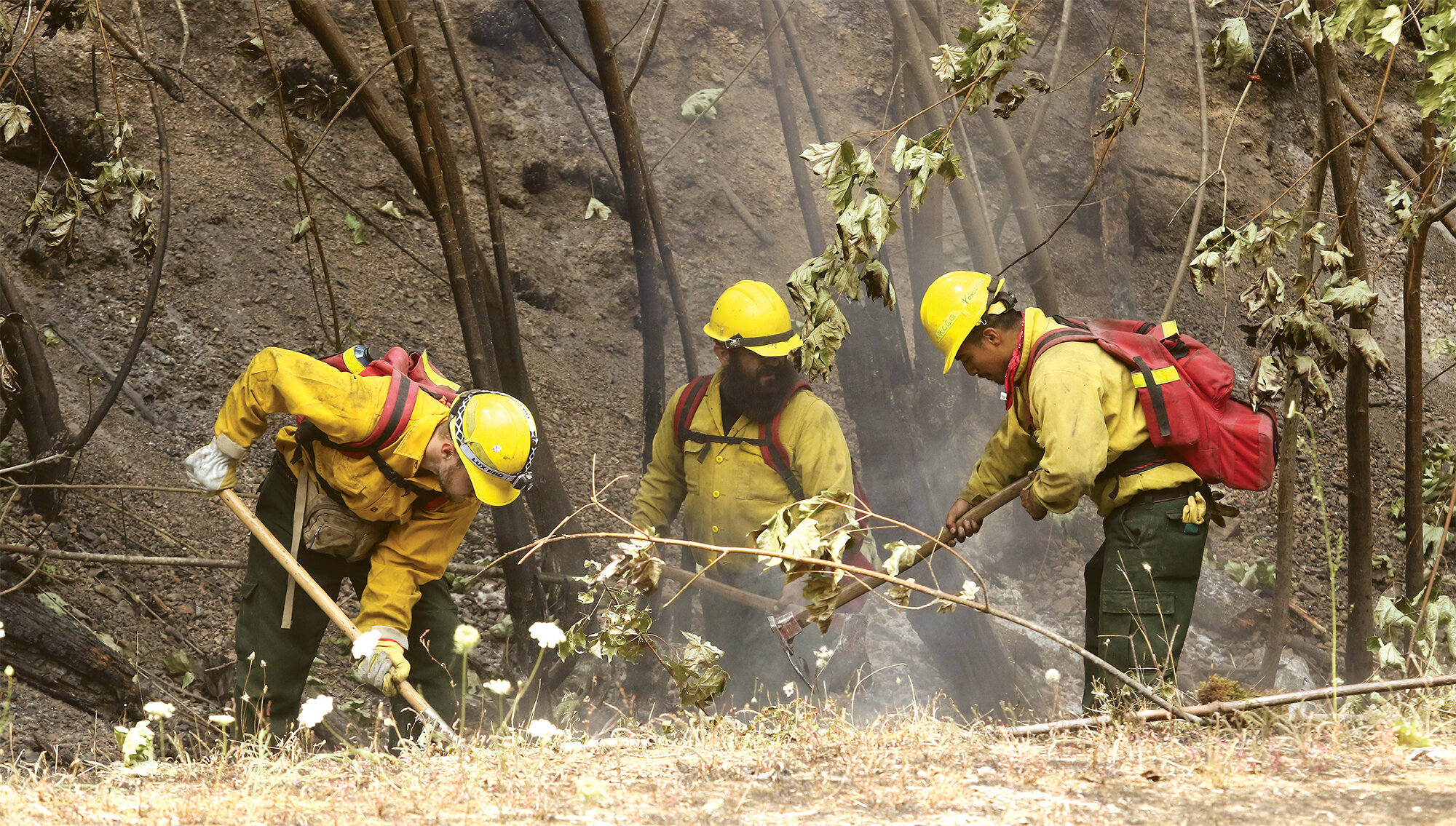The Long Yellow Line

Our writer shares his experience working on the team that overcame searing heat, rough terrain and 20-hour days to finally end the devastation from last summer’s Milepost 97 fire.
Story by David Shroyer
A convoy of fire trucks weaves through the mountains. Firefighters are crunched together inside, sweaty and smoked-out. Grey plumes seep over the charred road, as they make their way to the next drop off. Radio static hums. Orders from the lead truck snap across walkie-talkies, then a cadence of “copy that” is repeated from each rig.
Deep in the woods, hand tools tightly clutched, chainsaws hoisted atop shoulders, the crew makes its descent into the smoky abyss in a single file, yellow line—hive mentality, eyes cast over each another’s shoulders.
Milepost 97 fire in Canyonville, Oregon was my first experience on a wildfire. This blaze claimed over 13,000 acres of forest in Douglas County, Oregon in late July 2019, amassing over 10 million dollars in damages.
Firefighters during a training exercise. Photo by Thomas Boyd.
Steep, rocky terrain and thick, old growth Douglas firs made this a considerably large andtreacherous fire. I came in on the latter half of it, at a process of containment called “mop-up.”
Mop-up is the last stage of controlling a fire. After a control line has been constructed around the fire, crews then canvas the area with water hoses, shovels or pulaskies (an axe/hoe combo), searching for “smokers” and “hotspots,” sometimes gridding the terrain on hands and knees, poking and prodding the earth, feeling for heat.
Although it’s one of the last steps in fire containment, mop-up is when most accidents happen. Burnt and broken trees, known as snags, can topple at the slightest breath of wind, potentially taking out multiple personnel. Embers from smoldering fuels can swiftly move up into a gust and land in unburned pockets of vegetation, igniting, causing spotfires to break out across control lines.
The mop-up in Canyonville was no exception from danger. Hundreds of hazard trees hung in wait. We scuttled near-vertical rockslides, skirted fire-baked boulders, and dug out burning tree roots the size of mini buses, dragging knuckles to the ground, scouring for heat.
Photo by Michael Sullivan.
While hazards and complications out on a fire are ever-present, back home families tackle their own snags with the absence of those loved one. Emergencies pop up, and plans are put on hold.
A fire in Jacksonville, Oregon sometime in mid August found my crewmember Sean Steele in somewhat of a hotspot of his own. He and his expecting fiancé had an upcoming ultrasound: the baby’s heartbeat. But the hot and dry fire conditions took us down south instead, while his fiancé had to bear this milestone alone.
This was Sean’s first child, and he wore an anxious look as the convoy drove down the interstate.
This is the life of a wildland firefighter: on the road and in the mountains, camping for weeks on end; most the time without showers. No shaving. They go days without outside communication. They are alone out there in that wide, green and black, backyard. So close to home, but mountains away. Fighting fire in the wild.
Sean Steele started fire fresh in his mid twenties. Now on his third season, he has donned the rank as a firefighter Type 1, or better known as a squad boss.
He quickly made his way up in rank due to his fearless wits. Some might call him a little gung-ho at times—sprinting up hills, and yelling “get some!” as a fire moves closer—but it’s people like him that hold others accountable, push their fellow crewmembers to be just as good as the next person, following orders and safety protocol to a T.
“My favorite thing on a fire,” Sean says to the occupants of his truck on our way to an incident. “Punching in line! Running a saw. My Adrenalin flowing. Fire all around—just eating wood chips and smoke. Hooyeahh!”
He says this with a daredevil smile, bordering on insanity. He is always the first up the side of a mountain, dragging tools and water hose, and he expects his crew to be right next to him pumping out the same effort he does. And they do!
“I’m here to fight fires,” he says. “We all are. So if there’s anyone on this crew not pulling their weight, they are a danger to us, and themselves.”
This mentality is not foreign to a fire crew. Within the first couple of days on a fire, the bosses know who their weakest links are, and they mean to shape them up, or, well... you get the picture.
A fireline is a dangerous place, and anybody not 100% devoted to the crew, to the fire, whether it’s digging line, running a hose, or just mopping up, they can be potential risks to all. That’s why firefighters like Steele have to set the pace for the rest of the crew. But even with keen leadership, and 20 firefighters all in tune, danger is always present, and accidents happen.
On a fifteen-acre fire near Elkton, Oregon I nearly lost my head from a flaming, ten-foot log smashing down a steep hill. We were in a Douglas fir grove, timberland, in the bottom of a tight, slot canyon. Trees were lodged sideways and understory was thick as a mangrove jungle.
The air was heavy with dry smoke. An orange, 6 pm haze glowed through the canopy.
It was next to impossible to tell which direction the log would go, as it rolled and crashed end to end, just a few feet above. The crew scattered to either side. And like a goalie, I wildly dove. However, the rambling log changed direction as I leapt.
I braced for impact.
Luckily, a tree root caught my leg as I lunged, and it tugged me down fast to the forest floor. I could feel the hot air, inches away, whizz past my face.
Without thinking I was snatched up to my feet by my squad boss, patted down, and put back in line.
About fifteen minutes later, up the fern-encrusted canyon, a rolling boulder the size of a melon took out the leg of a crewmember. But she got up too, dusted off, slightly unscathed, and continued scaling the canyon wall, digging fireline up a 70-degree incline.
These kinds of accidents are all too common on fire. Loose footing, falling trees, and rocks can cut a crew down in size instantly.
Squad bosses contemplate which direction to cut line uphill. Photo by David Shroyer.
Another crew experienced this first hand on the Elkton fire before we showed up.
Driving up the mountain, my crew was met by an ambulance on its way down. A firefighter lost their footing while climbing into the canyon, and took a serious tumbled, breaking their back from the fall.
The flashing blue and red light was our fanfare to this fire. All eyes were sharp as glass thereafter.
As we made our descent into the canyon on foot, helicopters buzzed above us, dumping water on the fire, getting closer every drop, drenching the forest and the firefighters. We cheered as branches snapped and trees sizzled around us, the drops hitting their targets.
By the second day, smoke and a high-pressure system made visibility poor, and helicopter runs out of the question—completely eliminating that aerial safety line. We were on our own.
With hotter and drier temperatures, conditions had become dire. Trees began to group torchin — igniting from the top down — sending embers across our line, creating hotspots and spreading us thin. The fire was creeping down hill to our position, and our water pumps at the top of the canyon lost pressure, failed, and burnt up, losing that lifeline as well.
We were almost outflanked. Everyone scrambled to remove any unburned fuel between our line and the looming fire. Chainsaws chewed up giant logs and dense, dry brush. Shovels and pulaskies moved tirelessly, scattering debris like dogs. Orders were barked. Bodies reacted. Things looked grim.
But we kept on. Nobody stopped for a second, even as a spotfire moved closer to our only escape route. Thanks to the hard work, mineral soil was found, and then replacement pumps showed up soon after. Water tenders filled our water tanks above, and tree fellers took out the flaming firs.
The different modes of firefighting came together all at once: fellers, engines, hand crews, and we were able to stop the fire head on, containing it and preserving the forest, and our lives.
Close to the end of the season, on a fire somewhere in Southwest Oregon, we began to see the wildlife move back in as we mopped up. The deer crept between the scorched trees, and the squirrels ventured out in search of BBQ’d acorns. Light shown through the treetops, and songbirds lifted the air with their tune.
Life will continue on long after the chaos of a forest fire. The firefighters move on from one fire to the next, growing, adapting to a hotter and drier climate, while families continue on strong back home. It’s a community of support, people pooling their resources, convening efforts, protecting the lives and livelihood of the people and wildlife of the Pacific Northwest.
Fluttering around the crew, a little white butterfly with purple spots bounced from person to person, landing on hard hats and fingertips as we marched out of the mountains in a single file, yellow line.








